Ford Puma vs Hyundai IONIQ 5 – Which model is better for everyday use?
Compare performance, boot capacity, efficiency and price at a glance.
Find out which car is the better choice for you – Ford Puma or Hyundai IONIQ 5?
Costs and Efficiency:
When it comes to price and running costs, the biggest differences usually appear. This is often where you see which car fits your budget better in the long run.
Ford Puma has a significantly advantage in terms of price – it starts at 24800 £, while the Hyundai IONIQ 5 costs 38500 £. That’s a price difference of around 13714 £.
In terms of energy consumption, the advantage goes to the Ford Puma: with 13.10 kWh per 100 km, it’s somewhat more efficient than the Hyundai IONIQ 5 with 15.60 kWh. That’s a difference of about 2.50 kWh.
As for range, the Hyundai IONIQ 5 performs clearly perceptible better – achieving up to 570 km, about 194 km more than the Ford Puma.
Engine and Performance:
Under the bonnet, it becomes clear which model is tuned for sportiness and which one takes the lead when you hit the accelerator.
When it comes to engine power, the Hyundai IONIQ 5 has a clearly edge – offering 650 HP compared to 168 HP. That’s roughly 482 HP more horsepower.
In acceleration from 0 to 100 km/h, the Hyundai IONIQ 5 is significantly quicker – completing the sprint in 3.50 s, while the Ford Puma takes 7.40 s. That’s about 3.90 s faster.
In terms of top speed, the Hyundai IONIQ 5 performs somewhat better – reaching 260 km/h, while the Ford Puma tops out at 210 km/h. The difference is around 50 km/h.
There’s also a difference in torque: Hyundai IONIQ 5 pulls significantly stronger with 770 Nm compared to 290 Nm. That’s about 480 Nm difference.
Space and Everyday Use:
Cabin size, boot volume and payload all play a role in everyday practicality. Here, comfort and flexibility make the difference.
Both vehicles offer seating for 5 people.
In curb weight, Ford Puma is decisively lighter – 1316 kg compared to 1955 kg. The difference is around 639 kg.
In terms of boot space, the Ford Puma offers barely noticeable more room – 523 L compared to 520 L. That’s a difference of about 3 L.
In maximum load capacity, the Hyundai IONIQ 5 performs to a small extent better – up to 1580 L, which is about 297 L more than the Ford Puma.
When it comes to payload, Hyundai IONIQ 5 somewhat takes the win – 530 kg compared to 469 kg. That’s a difference of about 61 kg.
Who wins the race?
The Hyundai IONIQ 5 proves to be leaves the rival little chance and therefore becomes our DriveDuel Champion!
Hyundai IONIQ 5 is the better all-rounder in this comparison.
 @ Hyundai Motor Company
@ Hyundai Motor Company
Hyundai IONIQ 5
Ford Puma
The Ford Puma is a cheeky compact crossover that blends sporty styling with city-friendly practicality, giving drivers a surprisingly fun and composed ride. With clever storage tricks and a lively personality, it’s a smart pick for buyers who want enjoyment without fuss.
details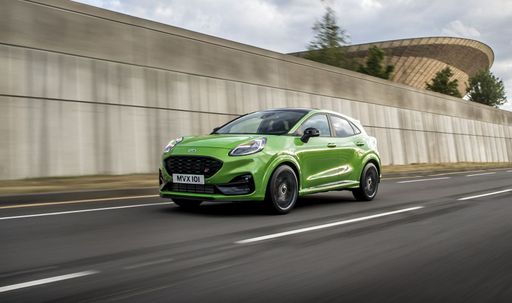 @ Ford Motor Company / Ford Media Center
@ Ford Motor Company / Ford Media Center
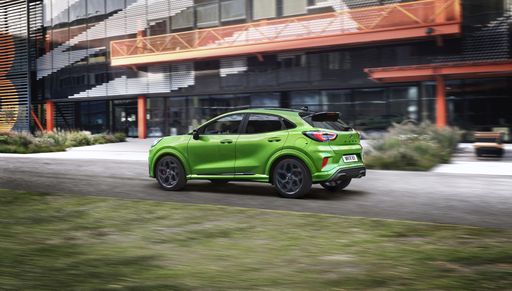 @ Ford Motor Company / Ford Media Center
@ Ford Motor Company / Ford Media Center
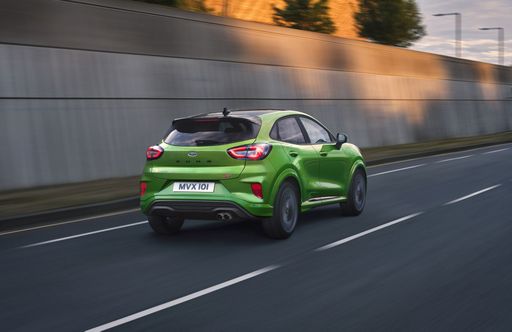 @ Ford Motor Company / Ford Media Center
@ Ford Motor Company / Ford Media Center
 @ Ford Motor Company / Ford Media Center
@ Ford Motor Company / Ford Media Center
Hyundai IONIQ 5
The Hyundai IONIQ 5 looks like a spaceship that moved into suburbia, pairing bold retro‑futuristic styling with a roomy, cleverly laid-out cabin that makes long trips surprisingly comfortable. Its electric character delivers instant, silky acceleration and low running costs, making it a smart, slightly cheeky pick for buyers who want tech, practicality and personality without the drama.
details @ Hyundai Motor Company
@ Hyundai Motor Company
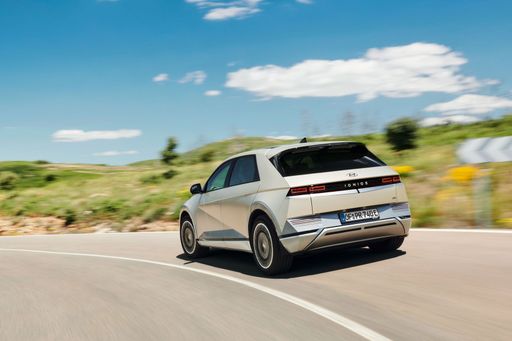 @ Hyundai Motor Company
@ Hyundai Motor Company
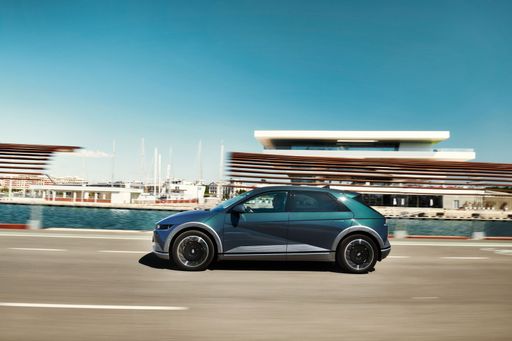 @ Hyundai Motor Company
@ Hyundai Motor Company
 @ Hyundai Motor Company
@ Hyundai Motor Company
 @ Hyundai Motor Company
@ Hyundai Motor Company
 @ Ford Motor Company / Ford Media Center
@ Ford Motor Company / Ford Media Center
|
 @ Hyundai Motor Company
@ Hyundai Motor Company
|
|
|
|
Costs and Consumption |
|
|---|---|
|
Price
24800 - 36300 £
|
Price
38500 - 64200 £
|
|
Consumption L/100km
5.4 - 5.9 L
|
Consumption L/100km
-
|
|
Consumption kWh/100km
13.1 - 13.9 kWh
|
Consumption kWh/100km
15.6 - 21.2 kWh
|
|
Electric Range
361 - 376 km
|
Electric Range
440 - 570 km
|
|
Battery Capacity
43 kWh
|
Battery Capacity
63 - 84 kWh
|
|
co2
0 - 135 g/km
|
co2
0 g/km
|
|
Fuel tank capacity
42 L
|
Fuel tank capacity
-
|
Dimensions and Body |
|
|---|---|
|
Body Type
SUV
|
Body Type
SUV
|
|
Seats
5
|
Seats
5
|
|
Doors
5
|
Doors
5
|
|
Curb weight
1316 - 1563 kg
|
Curb weight
1955 - 2275 kg
|
|
Trunk capacity
456 - 523 L
|
Trunk capacity
480 - 520 L
|
|
Length
4186 - 4226 mm
|
Length
4655 - 4715 mm
|
|
Width
1805 mm
|
Width
1890 - 1940 mm
|
|
Height
1550 - 1555 mm
|
Height
1585 - 1605 mm
|
|
Max trunk capacity
1216 - 1283 L
|
Max trunk capacity
1540 - 1580 L
|
|
Payload
367 - 469 kg
|
Payload
385 - 530 kg
|
Engine and Performance |
|
|---|---|
|
Engine Type
Electric, Petrol MHEV
|
Engine Type
Electric
|
|
Transmission
Automatic, Manuel
|
Transmission
Automatic
|
|
Transmission Detail
Reduction Gearbox, Manual Gearbox, Dual-Clutch Automatic
|
Transmission Detail
Reduction Gearbox
|
|
Drive Type
Front-Wheel Drive
|
Drive Type
Rear-Wheel Drive, All-Wheel Drive
|
|
Power HP
125 - 168 HP
|
Power HP
170 - 650 HP
|
|
Acceleration 0-100km/h
7.4 - 9.8 s
|
Acceleration 0-100km/h
3.5 - 8.5 s
|
|
Max Speed
160 - 210 km/h
|
Max Speed
185 - 260 km/h
|
|
Torque
170 - 290 Nm
|
Torque
350 - 770 Nm
|
|
Number of Cylinders
3
|
Number of Cylinders
-
|
|
Power kW
92 - 124 kW
|
Power kW
125 - 478 kW
|
|
Engine capacity
999 cm3
|
Engine capacity
-
|
General |
|
|---|---|
|
Model Year
2025
|
Model Year
2024 - 2025
|
|
CO2 Efficiency Class
A, D
|
CO2 Efficiency Class
A
|
|
Brand
Ford
|
Brand
Hyundai
|
Is the Ford Puma offered with different drivetrains?
The Ford Puma is offered with Front-Wheel Drive.
The prices and data displayed are estimates based on German list prices and may vary by country. This information is not legally binding.
